There seems to be a common notion these days that centre-backs need to be a certain height to be effective at the top level.
Sure, tall defenders have some advantages, but as this data analysis will uncover, centre-backs under six feet tall also have the potential to be effective.
Plenty of ‘short’ central defenders have been successful at the top level over the years—Fabio Cannavaro, Carles Puyol, Franco Baresi, and Bobby Moore, to name but a few—legendary names in our sport who were not hampered by their height.
In recent years, we’ve seen César Azpilicueta do a fine job at centre-back in the Premier League for Chelsea.
Another former Chelsea player, Thiago Silva, has also had a very successful career as a central defender under six feet.
The height of a central defender has always been a talking point.
Depending on team tactics and other factors, some sides prefer to sign a physical presence at the back, but there seems to be more attention on some shorter centre-backs than others.
Take Lizandro Martínez, for example.
He did a stellar job in the Eredivisie for Ajax and is now a regular starter for Manchester United despite a somewhat rocky start to life in the Premier League.
Yet, due to his height, he receives more negative attention than some of the other shorter centre-backs in the Premier League.
We aren’t saying that Martínez, in this example, should be regarded in the same bracket as the legendary names we mentioned earlier.
Still, we cannot
disregard a central defender because of their height—this data analysis looks to uncover how short centre-backs can be effective inelite football.
Criteria
To get a good sample size and a wide range of different football tactics, we extended our search beyond just the English Premier League—all defenders involved in this data analysis are, as of the start of the 24/25 league campaign, playing for clubs in either the Premier League, Spain’s La Liga, or Italy’s Serie A (doing it this way also allowed us to include a higher number of ‘high profile/value’ players).
The data used in this analysis dates back to the beginning of the 23/24 campaign, giving us more reliable data to work with rather than using player statistics from the opening 10 or so games from this season.
While some of the players on this list can and have also played in other positions, according to Wyscout, we have selected players whose primary position is central defender.
There was no minimum limit for the number of minutes played, and only one player involved has featured in less than 1000 minutes of league football since the start of last season.
Regarding the search itself, we conducted two searches – one that shows us centre-backs over 6 feet (183cm+) and one that shows us centre-backs under 6 feet (182cm and under).
The latter of the above came first as there are fewer short centre-backs in the given leagues than tall centre-backs—the search gave us six centre-backs from the EPL, four from Serie A, and 14 from La Liga, for a total of 24 centre-backs.
When it came to the search for 6-foot-plus centre-backs, we replicated the results of the prior search to give us our 24 tall centre-backs – the top 6 from the EPL, the top four from Serie A, and the top 14 from La Liga based on market value.
Defensive Contribution
Regardless of height, being an effective competitor in terms of defensive actions is a given.
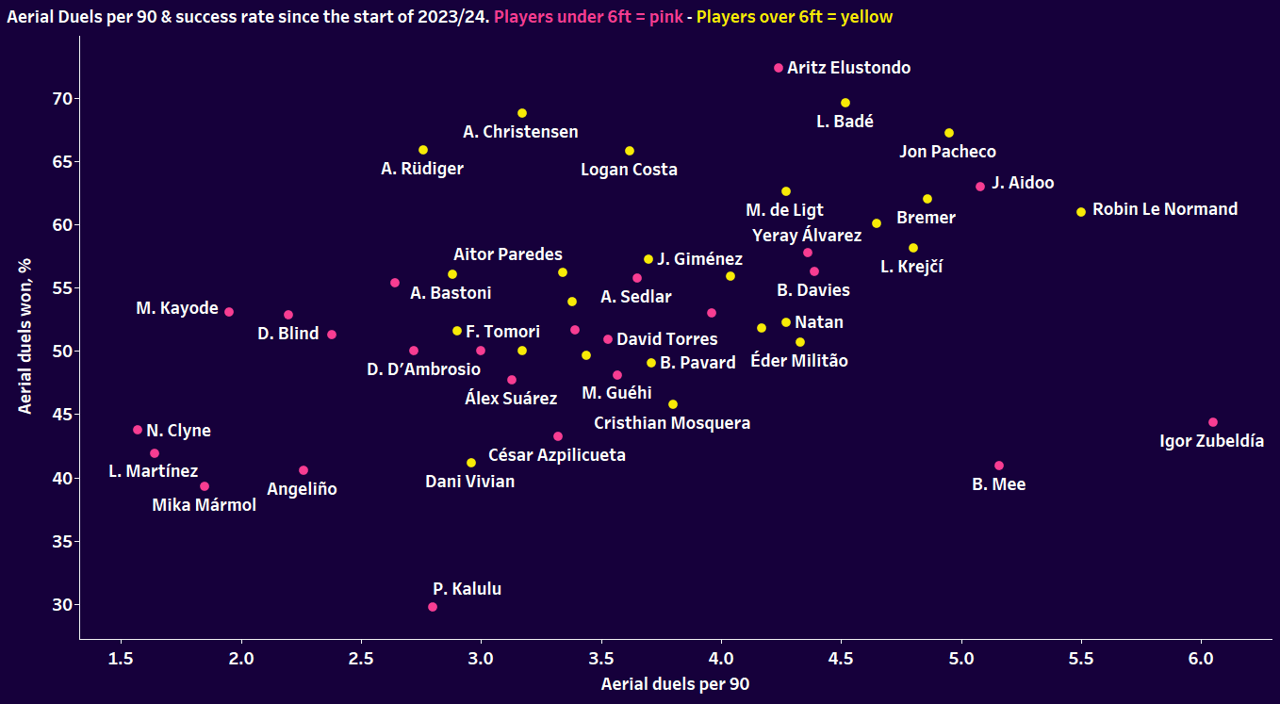
We start with the metric that brings the most attention regarding short defenders – aerial duels.
Some argue that any centre-back at the top level should bring enough physical presence to compete in the air and that shorter centre-backs cannot tick that box.
The data above needs unpacking slightly before we start to make our own judgements.
As you can see, generally, many of the centre-backs under 6 feet average a lower engagement rate for aerial duels compared to the over-6-foot centre-backs – similar can be said of their success rates, with the taller defenders proving that height is vital for being effective in the air… for the most part.
We have a couple of players who defy that notion, most notably Aritz Elustondo of La Liga club Real Sociedad, who has a high engagement of 4.24 aerial duels per 90, which comes with an excellent success rate of 72.41% – the 5’9” defender proving that short defenders can be effective in the air if they have the right attributes.
However, as we mentioned, the data generally suggest that shorter defenders are less active and less effective in aerial duels at the top level.
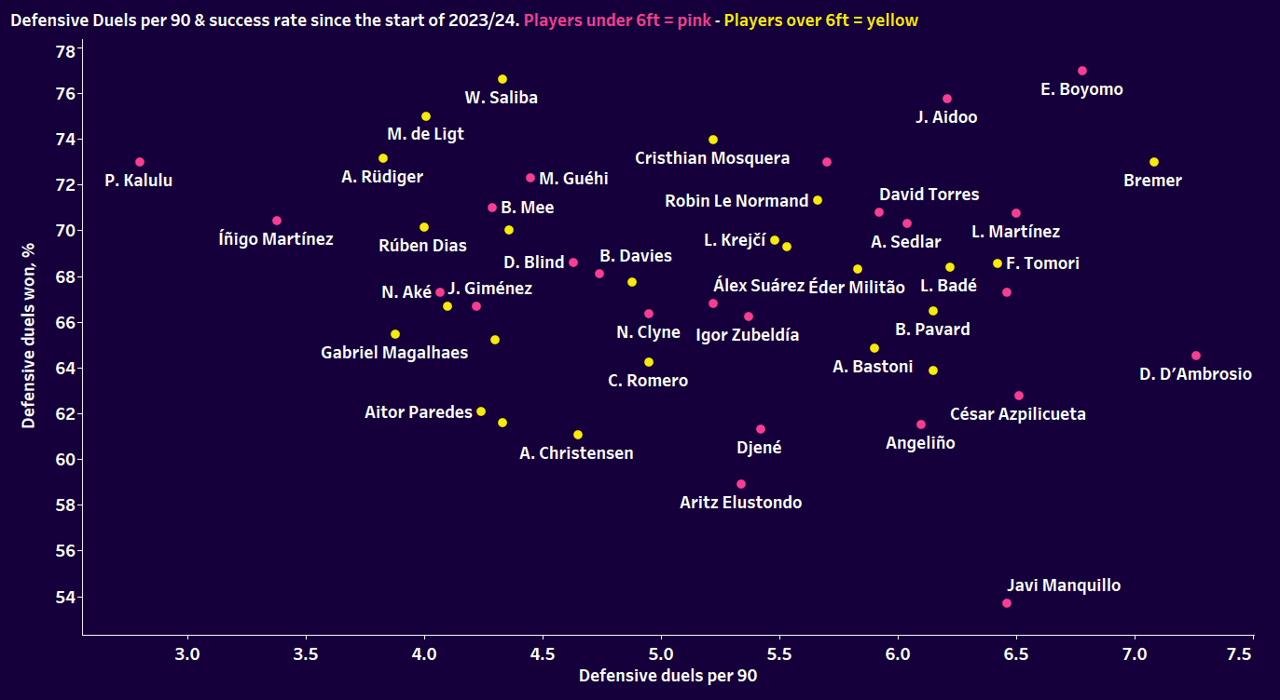
Some interesting points arise when comparing the two sets of defenders in defensive duels.
As far as this data set goes, shorter defenders engage more in defensive duels—a sign of a more aggressive approach as they look to meet the oncoming danger head, giving them a chance to use their speed and intensity to good defensive impact.
There isn’t too much of a story as far as success levels go, but there is some thinking to be done about taller centre-backs generally being less involved in defensive duels.
Some of the shorter centre-backs with high engagement are also proving their worth with high success rates—Enzo Boyomo (Osasuna), Joseph Aidoo (Celta Vigo, less than 1000 league minutes in a given time frame), David Torres (Real Valladolid), Aleksandar Sedlar (Deportivo Alavés), and Manchester United’s Lisandro Martínez all prove to be effective on a regular basis.
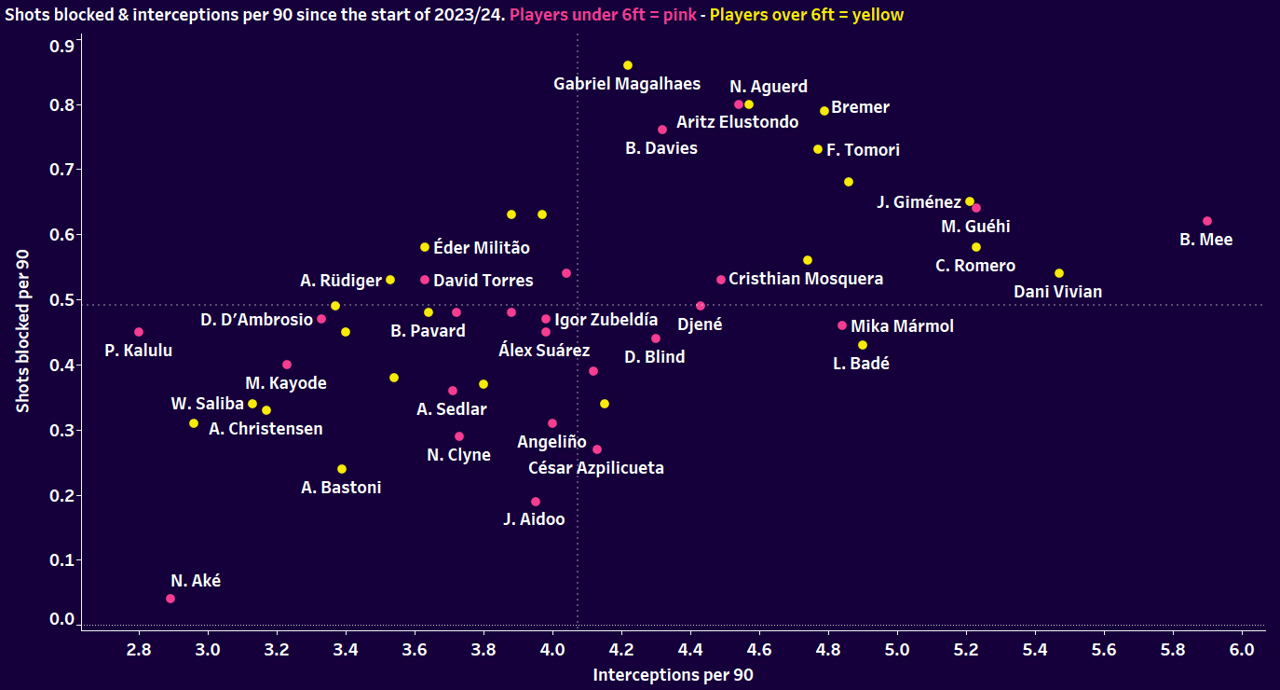
Intercepting play and putting your body on the line to block shots are two more important parts of being a central defender at the top level.
Here, we see more patterns emerging—generally speaking, the tall defenders appear to make more interceptions.
This makes sense if you consider the results of the defensive duels data; if the shorter defenders engage in more defensive duels, the taller centre-backs will likely take up more reserved positions to intercept crosses and passes into the box.
As is usually the case, there are a couple of outliers to that notion – Crystal Palace’s Marc Guéhi and Brentford’s Ben Mee, for example, have high averages when it comes to making interceptions.
It’s a similar story when it comes to blocking shots, with the taller defenders being more active here.
However, Tottenham Hotspur defender Ben Davies challenges that notion with a high rate of blocking shots.
Elustondo shines again in another defensive metric, thanks to his high engagement with blocking shots.
In-Possession Talents
The role of a modern central defender can take several different forms, but many clubs at the top level require their centre-backs to be competent on the ball and able to carry the ball forward.
This segment of analysis will assess the included defenders’ ability in various dribbling metrics.
Passing metrics have not been included, as height has little bearing on passing ability/tendency.
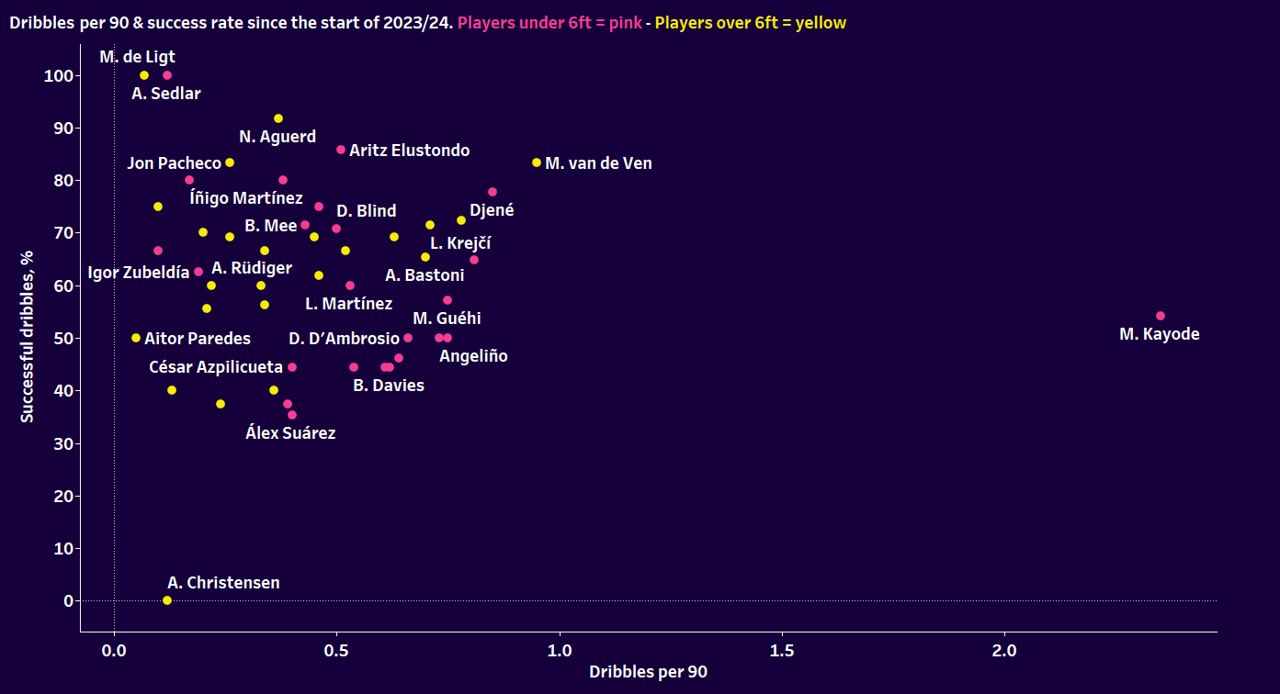
This data analysis has been about spotting patterns within different game actions, which doesn’t stop here.
The data suggests that shorter defenders are more active when it comes to running with the ball.
This could be due to a number of factors, including tactical factors, but shorter players are often quicker and more agile, which can come in handy when carrying the ball.
You’ll notice that, despite the higher general engagement rate for short centre-backs dribbling, there are a number of them who fall on the lower end of the scale when it comes to being successful – which could be down to a lack of strength (compared to tall centre-backs) to protect the ball when dribbling.
While they generally have a higher engagement, the taller centre-backs appear to be more successful in their attempts.
There are a couple of ways to look at those stats.
You could argue that the tall centre-backs only have a higher success rate because of their lower engagement rate; arguably, a lower engagement rate means less opportunity for failure.
You could also argue that the 6-foot-plus defenders bring more physicality to the table, which enables them to protect the ball more effectively when dribbling.
Individual traits and team tactics are important to consider when considering why a couple of the taller centre-backs have a higher dribble engagement than the rest of the group.
For example, Micky van de Ven has a high engagement (and high success rate as well).
This is due to his individual technical ability on the ball and his pace—we’ve seen him burst forward with the ball in a Spurs shirt on a number of occasions.
A different example would be Inter’s Alessandro Bastoni, who also has a relatively high engagement rate for dribbles.
While Bastoni does possess on-the-ball qualities that make him vital for Inter, their tactics and formation encourage the defenders to be influential in possession, which includes running forward with the ball.
Bastoni plays as the left centre-back in a back three for Inter, with both the left centre-back and right centre-back given important attacking roles, hence Bastoni’s high dribble engagement.
We’ll touch on a couple of theories on why short centre-backs are more active in certain areas of the game later on.
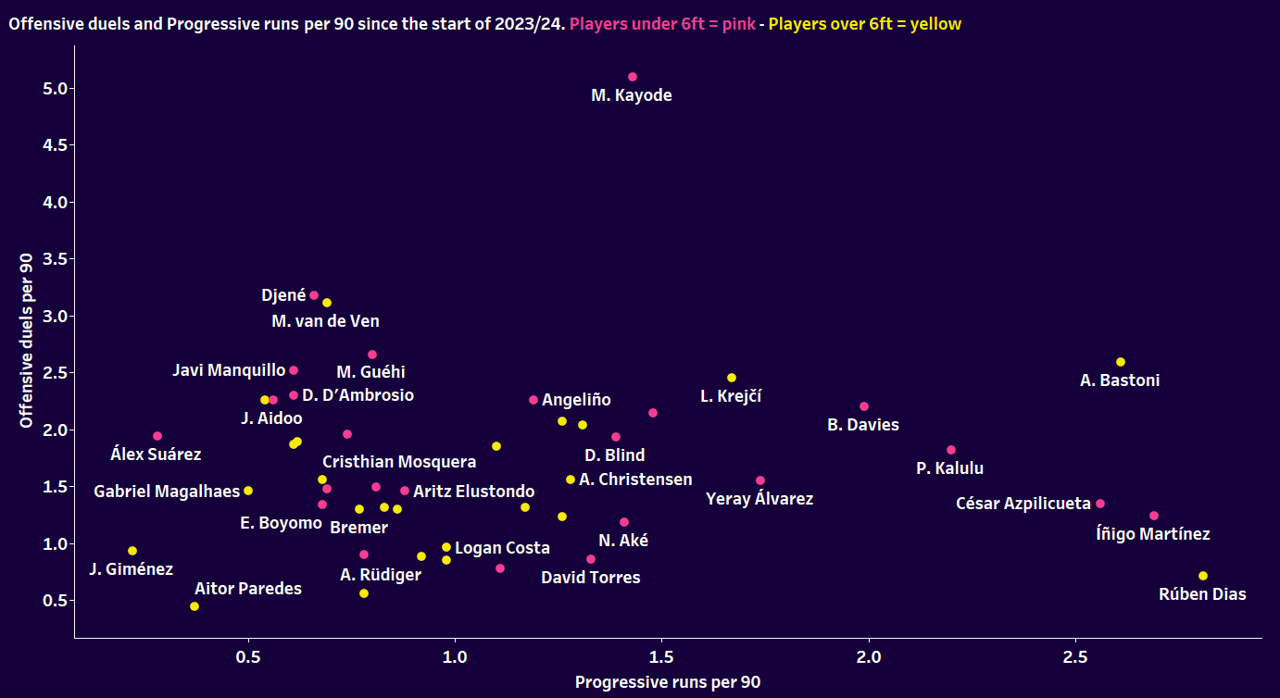
This final set of statistics extends the previous analysis regarding centre-backs running with the ball; only this time do we get to see which group is more active in carrying the ball over a large distance that brings it closer to the opposition goal.
We’ve included the progressive runs metric alongside the dribbles per 90 metrics to better understand each player’s dribbling tendencies.
Like the previous graph, shorter centre-backs appear to make more progressive runs than taller defenders at the top level.
Though we see some tactical anomalies, Bastoni and Manchester City’s Rúben Dias often engage with progressive runs for reasons we discussed in the previous graph analysis.
Conclusion
Some interesting patterns and theories have emerged due to this data analysis.
We’ve learned that central defenders under 6’ come with their apparent collective strengths and weaknesses.
While they are less prominent in aerial battles, they are more involved in defensive duels on the ground.
Shorter centre-backs can also offer an alternative presence in possession, with many of them generally being able to carry the ball forward more regularly than taller defenders.
As we have touched on, several reasons impact different areas of a centre-back’s output.
The formation and tactical system a player is operating in can influence their statistical output.
Positional versatility can also play a role.
Speaking of positioning versatility, there is an argument that shorter centre-backs offer more in that area—quite a lot of them also play as full/wing-backs or even as defensive midfielders.
This is not to say that taller centre-backs can’t offer the same versatility, but shorter centre-backs are more often than not more positionally versatile.

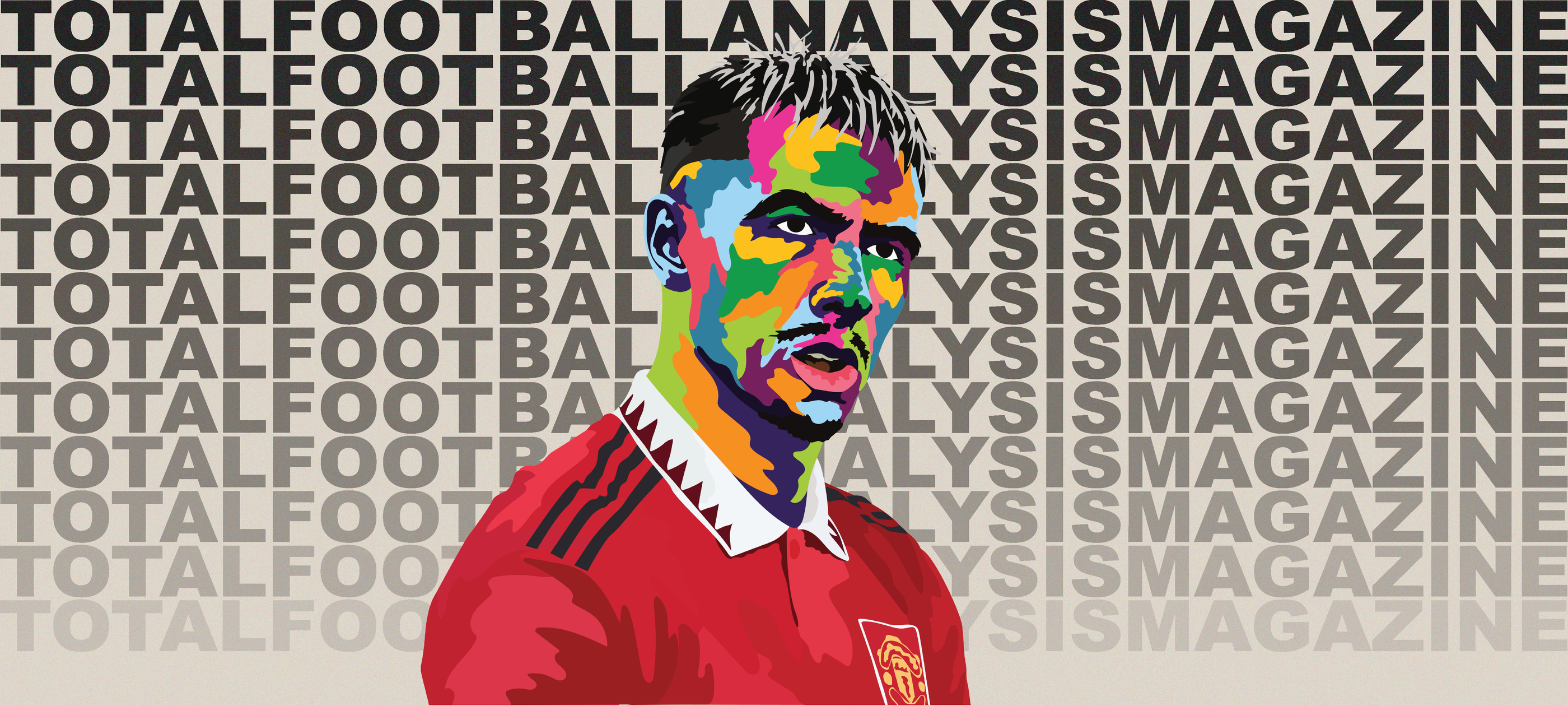




Comments